Winter Preparation, 2019
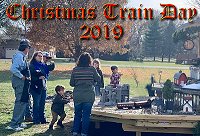 This is a followup to our article "Christmas Train Day, 2019. That article describes the second annual Christmas-themed open railroad at our new house, a tradition that we started at our old house in 2007. This is a followup to our article "Christmas Train Day, 2019. That article describes the second annual Christmas-themed open railroad at our new house, a tradition that we started at our old house in 2007.
Usually, I keep certain trains ready go to between this event and Christmas week, in case of visitors. In fact, we had some young visitors a few days ago, and having trains ready to run at a moment's notice was a big help.
I used to keep my model buildings and little figures out until Christmas week for the same reason, but the winds are brutal here, and more than one building has wound up in the water feature or in pieces in the grass. Not to mention the figures that disappeared altogether, in spite of being glued or weighed down.
Building Replacement - My old railroad always looked so naked after I put the model buildings and figures away, I started leaving NorthState's "Village" bird feeders on my railroad in the winter. I used to take the bases off so they wouldn't look so much like bird feeders.
I'm continuing that tradition at the new place. But we have much higher winds, so they kept blowing off the railroad, too. So I started leaving the bases attached and filling them with gravel.
That looks a little silly close up, but they stay in place, despite our high winds.
 On the new extension, which I haven't dirtscaped yet, I poured the gravel so thick around the buildings I set out for our open railroad that you can't even see the bases. On the new extension, which I haven't dirtscaped yet, I poured the gravel so thick around the buildings I set out for our open railroad that you can't even see the bases.
That's not something I can do with my model buildings, of course. But it might be a useful tip for anyone setting up a temporary display railroad outside, who doesn't want to risk buildings blowing away or vandalism to a hundred-dollar building.
A Note About Planting for Winter - When I built my first railroad, I used a number of deciduous shrubs and trees, as well as perennials that froze back to the ground. So by Christmas, the leaves had fallen from my Japanese maple and dwarf boxwood, most of my sedums had shrunk back and lost their warm-weather colors, and several perennial groundcovers had disappeared entirely.
In other words, there was nothing appealing about the garden part of my garden railroad between December and late April. For almost half of the year, it looked abandoned and - frankly - dead. So I decided I needed year-round green stuff on my yard, meaning mostly evergreens, of course.
Over the following years, I experimented with any number of dwarf, low-growing, and miniature conifers, trying to have a railroad that had green on it all year 'round without just looking like I bought out Lowes' collection of Dwarf Alberta spruce. I had good luck with Hetz Midget Arborvitae, Dwarf Procumbens Juniper, Boulevard Cypress, and a few others that I do not have planted on the present railroad yet.
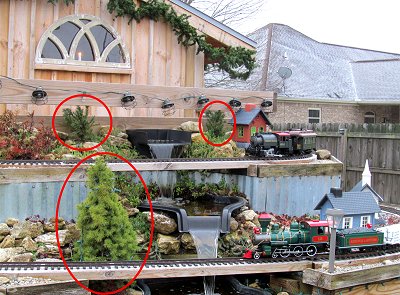 On the new railroad (started in 2017), I currently have two Taxus Hicksii and one Dwarf Alberta Spruce growing on the elevated parts of the railroad. I count that as a win, since they have only a few inches of soil to root in. On the new railroad (started in 2017), I currently have two Taxus Hicksii and one Dwarf Alberta Spruce growing on the elevated parts of the railroad. I count that as a win, since they have only a few inches of soil to root in.
In the photo to the right, which you can see more clearly in the blowup, various sedums have also greened the railroad up, including Stubby Fingers and Blue Spruce sedum. Those near the water stay greener longer because the water - even when its frozen - creates a microclimate. Still, they'll be a lot browner by February.
The reddish stuff near the upper left corner is a Gold Crown sedum that needs dead-headed. To the left of that is a dwarf boxwood that did not survive, despite being in exactly the same situation as the Taxus. Every garden railroad is a testbed of what will and work in various settings, you know. I have a spare Taxus Hicksii that will go there once I have time and the weather suits.
Don't let the red winter color of the Gold Crown sedum fool you - the same plant is still growing green at the back of the waterfall up against the corrugated steel.
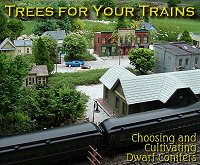
That said, I hope to have many more shrubs, especially conifers, growing once the lower level is complete. In fact, I have a plan that should allow shrubs on that layer to send roots all the way to the ground (more later). I mention this because even the few shrubs I have growing now help make the railroad seem "alive" through the winter as well.
For more tips about conifers that will keep your railroad looking green all winter long, check out our article "Trees for your Trains."
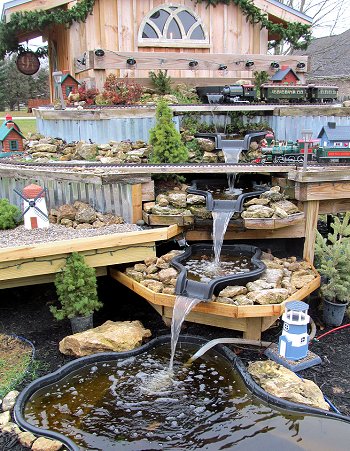 Preparing the Pond for Winter - As you know by now, we have a four-stage waterfall, using multiple small "connecting pools" and a 24"-deep inground pond. Preparing the Pond for Winter - As you know by now, we have a four-stage waterfall, using multiple small "connecting pools" and a 24"-deep inground pond.
All five layers are molded with slanting sides so that even if they freeze solid - which the upper four layers did once in November already - the ice expands upward instead of splitting the plastic. So having them freeze does not cause structural problems. The rest of this section will talk about the in-ground pond, which has plants and fish.
I don't treat my 35-cent goldfish as pets, per se, but the five I have now have been with me for several months and have put on some size, so I'd like to keep them going and growing if I can.
Some people think that the important thing is not letting them freeze solid. But I have a friend in Ottawa whose goldfish all freeze solid into the ice every winter and come out as "good as new" every spring.
Other folks think that getting oxygen under the ice is important. They're close, but that's not exactly what needs to happen. The real problem is the buildup of carbon dioxide under an iced-over pond - the fish don't die from lack of oxygen, but from CO2 poisoning.
On my first pond, I tried using a heater to keep a hole open in the ice all winter. But it added significantly to my electric bill.
 Later, I started using aquarium air pumps to pump air through "airstones." Yes, the fresh air helped oxygenate the pond, but more importantly, it forced the carbon dioxide to find its way out. I would protect the pump by putting it inside one of my little buildings. That kept my fish alive every year except the winter the building covering it was buried in a foot of snow and I didn't realize the pump had gone out until the snow melted. Later, I started using aquarium air pumps to pump air through "airstones." Yes, the fresh air helped oxygenate the pond, but more importantly, it forced the carbon dioxide to find its way out. I would protect the pump by putting it inside one of my little buildings. That kept my fish alive every year except the winter the building covering it was buried in a foot of snow and I didn't realize the pump had gone out until the snow melted.
I should point out that all these aquarium pumps have a rubber diaphragm that will eventually give out in cold weather, so generally they won't last more than one winter regardless.
Last year, I didn't have an in-ground pond, and I didn't imagine my fish would survive in the little 30-gallon above-ground utility tub, so I didn't take any precautions. But somehow they did.
This year I wanted to be a little more pro-active, so I bought a slightly larger pump than I usually did and bought two aquarium "bubblers" that have built in color-changing LEDs.
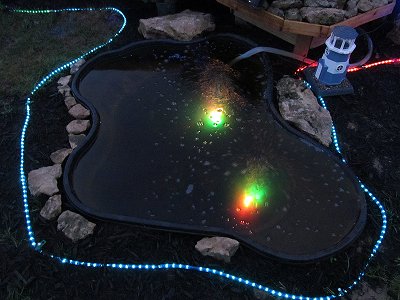 The LED bubblers fulfil another function - when they're on after dark, you can tell where the pond is, which reduces the chance of someone stepping into it by accident. And hopefully, I can see if the system is operating properly, even with ice on the pond. The LED bubblers fulfil another function - when they're on after dark, you can tell where the pond is, which reduces the chance of someone stepping into it by accident. And hopefully, I can see if the system is operating properly, even with ice on the pond.
In the photo to the right, the bubblers are changing color from red to green (yellow appears temporarily during the transition). They slowly change to several other colors, to keep things interesting.
By the way, these bubblers are not rated for outdoors, but I priced similar lights that were made for outdoor ponds and they cost several times as much and didn't do as much. So we'll see how they hold up.
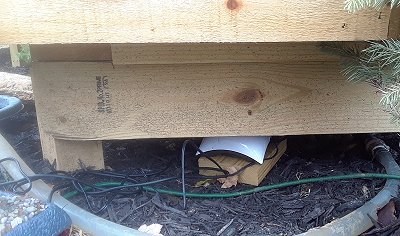 To test things out, I set the pump on a ground-rated board well under the lowest platform, which should protect it from rain. Then I put the pump and bubblers on a timer that comes on at dusk and shuts off after two hours. (The timer is within reach if I need to have it on longer than that, say, for visitors staying after dark.) Two hours a day of bubbling should be fine, and will cut down on power use. To test things out, I set the pump on a ground-rated board well under the lowest platform, which should protect it from rain. Then I put the pump and bubblers on a timer that comes on at dusk and shuts off after two hours. (The timer is within reach if I need to have it on longer than that, say, for visitors staying after dark.) Two hours a day of bubbling should be fine, and will cut down on power use.
We'll see.
Sorting and Cleaning
In the meantime, I've spent a number of days just sorting through my "train stuff," all the random cars, track and locomotives I brought over when we moved in a hurry.
Also the garage where I plan to store most of my "train stuff," and where most of it currently resides, will need seriously cleaned, once everything is sorted and put up. And that 18-square-foot hole in the garage ceiling that the previous owner left me needs fixed.
Fixing? - I MAY spend some time this winter fixing "train stuff" that I never had time to fix before the move. There's a very long list. Especially since two of my favorite Large Scale suppliers have gotten out of the business and many replacement parts are impossible to find. Let's just say, I've stopped giving away pieces that were too damaged to be worth fixing. Now they're spare parts and aren't going anywhere.
But I'm retired now, so theoretically I have all the time in the world. You other homeowners know just what a joke that is, right?
Keep in Touch
Even though I've "mothballed" my figures and model buildings for the winter, I can get a short train or three on the track very quickly. So if you're headed toward or past Springfield, Ohio, please let me know, and I'll see if we can work out a quick visit.
Finally, please let us know about your ongoing projects. Ask questions, send corrections, suggest article ideas, send photos, whatever you think will help you or your fellow railroaders. In the meantime, enjoy your trains, and especially enjoy any time you have with your family in the coming weeks,
Paul Race
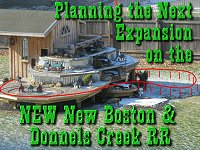 Proceed to Expansion Planning, 2020" - Three years after starting a garden railroad in our new home, we are trying to figure out the best way to finish the last loop of our raised platform railroad. How to make room for 10'-diameter curves and more towns and industries, but still keeping things manageable requires some thinking and rethinking. Proceed to Expansion Planning, 2020" - Three years after starting a garden railroad in our new home, we are trying to figure out the best way to finish the last loop of our raised platform railroad. How to make room for 10'-diameter curves and more towns and industries, but still keeping things manageable requires some thinking and rethinking.
Click on the photo to see the options we are reviewing for the next and last expansion.
 Return to "Christmas Train Day, 2019" - Three years after starting a garden railroad in our new home, we host another Christmas-themed open railroad, giving many families a jump start on Christmas celebrations and sharing the experience of running trains with lots of kids. Return to "Christmas Train Day, 2019" - Three years after starting a garden railroad in our new home, we host another Christmas-themed open railroad, giving many families a jump start on Christmas celebrations and sharing the experience of running trains with lots of kids.
Click on the photo to see a brief record of our busiest weekend in November, 2019.
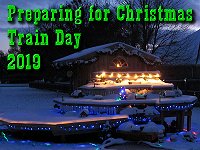 Return to "Preparing for Christmas Train Day 2019" - Wrapping up construction projects for 2019 and getting ready for our annual Christmas-themed open railroad. Includes new lighting and other features, providing a temporary home for a Hogwarts Express train, weather issues, and more. Click to go to article. Return to "Preparing for Christmas Train Day 2019" - Wrapping up construction projects for 2019 and getting ready for our annual Christmas-themed open railroad. Includes new lighting and other features, providing a temporary home for a Hogwarts Express train, weather issues, and more. Click to go to article.
Click on the following link to see our progress of mid-November, 2019.
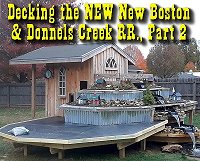 Return to Decking the NEW New Boston and Donnels Creek Part 2 - Getting the next part of the railroad ready to install trains. Includes installing 2"x6" decking, vinyl sheeting, edges to hold back the gravel, and corrugated steel panels. It's not done, but it will give us another place to set up trains for our next Christmas-themed open railroad. Return to Decking the NEW New Boston and Donnels Creek Part 2 - Getting the next part of the railroad ready to install trains. Includes installing 2"x6" decking, vinyl sheeting, edges to hold back the gravel, and corrugated steel panels. It's not done, but it will give us another place to set up trains for our next Christmas-themed open railroad.
Click on the photo to see our status as of late October, 2019.
 Return to "Framing the NEW New Boston and Donnels Creek RR - Part 7" - Installing posts, joists, framing, and decking for the eastern expansion of the NEW New Boston and Donnels Creek. Although this installation was complicated by having to fit into an existing framework, the methods used could work for any raised-platform railroad. Return to "Framing the NEW New Boston and Donnels Creek RR - Part 7" - Installing posts, joists, framing, and decking for the eastern expansion of the NEW New Boston and Donnels Creek. Although this installation was complicated by having to fit into an existing framework, the methods used could work for any raised-platform railroad.
Click on the following link to see our progress of early October, 2019.
 Return to "Planning the NEW New Boston and Donnels Creek RR - Part 5" - Once the major components of the water feature were installed and tested, we decided to add one more bit of railroad proper before our "Christmas Train Day," this November. The addition, about 5'x11', will allow us to put a small train and some scenery closer to eye level for youngsters. Eventually it will be part of the larger plan that will allow us to run our bigger cars and locomotives. Return to "Planning the NEW New Boston and Donnels Creek RR - Part 5" - Once the major components of the water feature were installed and tested, we decided to add one more bit of railroad proper before our "Christmas Train Day," this November. The addition, about 5'x11', will allow us to put a small train and some scenery closer to eye level for youngsters. Eventually it will be part of the larger plan that will allow us to run our bigger cars and locomotives.
Click on the photo to see our plans for the next addition, as of late September, 2019.
 Return to Waterscaping Part 4. - Installing the last connecting pool, so the whole planned waterfall is complete except for dirtscaping and planting. Return to Waterscaping Part 4. - Installing the last connecting pool, so the whole planned waterfall is complete except for dirtscaping and planting.
The process included checking the pump, extending the hoses, rescuing toads, building the platform, trimming the platform, testing the pool's location, etc.
Click the photo to go to the article.
 Return to "Waterscaping, Part 3" - After seven months of crazy long work hours, I finally got some free time to continue working on the railroad. Weather permitting, I often worked all the live-long day. This article describes installing two posts that will eventually support the last connecting pool, then digging the big hole for the in-ground pond, complicated by a three-month drought that turned the ground to concrete. Return to "Waterscaping, Part 3" - After seven months of crazy long work hours, I finally got some free time to continue working on the railroad. Weather permitting, I often worked all the live-long day. This article describes installing two posts that will eventually support the last connecting pool, then digging the big hole for the in-ground pond, complicated by a three-month drought that turned the ground to concrete.
Click on the photo to see our progress as of mid-September, 2019.
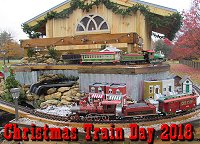 Return to Christmas Train Day, 2018 - After two years without our traditional Christmas Train Day (something we did from 2008 through 2015), we were anxious to get started again, even without a huge right of way to show off. The kids' trains, the extra Thomas railroad, the popcorn popper and two Bachmann Christmas trains got a big workout. And the visiting kids all loved it! Return to Christmas Train Day, 2018 - After two years without our traditional Christmas Train Day (something we did from 2008 through 2015), we were anxious to get started again, even without a huge right of way to show off. The kids' trains, the extra Thomas railroad, the popcorn popper and two Bachmann Christmas trains got a big workout. And the visiting kids all loved it!
Click on the photo to see a lot of last-minute preparations and some photos of the November 10, 2018 event itself.
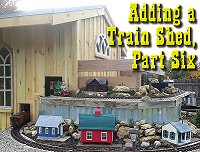 Return to "Adding a Train Shed Part 6" - Installing the board and batten siding on our train shed, installing the windows, installing the trim, testing the "tunnel entrances," and more. Return to "Adding a Train Shed Part 6" - Installing the board and batten siding on our train shed, installing the windows, installing the trim, testing the "tunnel entrances," and more.
By the way, going over lumber receipts in early 2019, I couldn't believe I was still siding the train shed in late October, and managed to have an open railroad in mid-November. It is a little crazy how fast things can go together if you have a deadline and a lot of gift cards.
Click on the photo to see our progress as of late October, 2018.
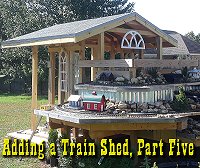 Return to "Adding a Train Shed Part 5" - Planning the doors, walls, and windows of our garden train shed. Return to "Adding a Train Shed Part 5" - Planning the doors, walls, and windows of our garden train shed.
Includes choosing the siding and windows, installing the door, painting the windowframes, and adding crosspieces to support the vertical siding boards.
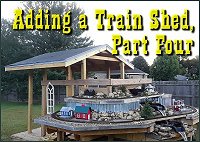 Return to "Adding a Train Shed Part 4" - Choosing and installing underlayment and drip edge to protect the sheathing until I can get the final roof installed. Return to "Adding a Train Shed Part 4" - Choosing and installing underlayment and drip edge to protect the sheathing until I can get the final roof installed.
Now the roof is waterproof enough to get us through the next couple of months at least, maybe more.
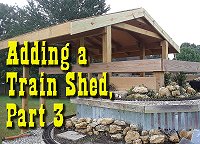 Return to "Adding a Train Shed Part 3" - Adding fascia, sheathing, and end trim to the in-progress train shed. Return to "Adding a Train Shed Part 3" - Adding fascia, sheathing, and end trim to the in-progress train shed.
I thought about bringing in helpers for this part, but a reader commented on how helpful it was to see how one person could do this sort of thing by himself, so I just kept plugging away.
Click on the photo to see our progress as of September 13, 2018
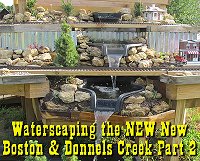 Return to "Waterscaping Part 2" - Getting this year's waterscaping project done (for now at least). Installing and dirtscaping the third level of the waterfall. Installing pump and filter, adding an extra container and modifying the ones we already had installed to keep the water running smoothly. And lots of other tweaking. Includes tips about introducing fish and plants, as well as other information about water features in general that you may find helpful. Return to "Waterscaping Part 2" - Getting this year's waterscaping project done (for now at least). Installing and dirtscaping the third level of the waterfall. Installing pump and filter, adding an extra container and modifying the ones we already had installed to keep the water running smoothly. And lots of other tweaking. Includes tips about introducing fish and plants, as well as other information about water features in general that you may find helpful.
Click on the photo to see our status as of August 5, 2018.
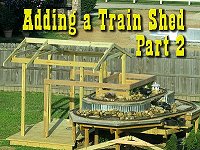 Return to "Adding a Train Shed Part 2" - Adding rafters to the frame of the in-progress train shed. Now it's starting to look like it might actually be a structure and not just a crazy collection of posts. Return to "Adding a Train Shed Part 2" - Adding rafters to the frame of the in-progress train shed. Now it's starting to look like it might actually be a structure and not just a crazy collection of posts.
The way we got the rafters and ridge board up wouldn't work for everybody, but it worked for us, and hopefully will help other folks to "think outside the box" - literally in this case.
Click on the photo to see our progress as of July 14, 2018.
 Return to "Adding a Train Shed Part 1" - What started out as a simple addition of a deck to stand on when putting trains on the track got a little more ambitious when I realized that JUST installing the deck this year would require more work next year. So we framed out what we planned to be a train shed attached to the railroad. If it ever gets finished, I can easily put trains on the track at a moment's notice instead of schlepping them out from the garage. Return to "Adding a Train Shed Part 1" - What started out as a simple addition of a deck to stand on when putting trains on the track got a little more ambitious when I realized that JUST installing the deck this year would require more work next year. So we framed out what we planned to be a train shed attached to the railroad. If it ever gets finished, I can easily put trains on the track at a moment's notice instead of schlepping them out from the garage.
Click on the photo to see our status as of July 9, 2018.
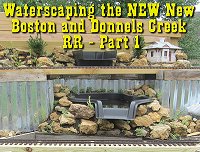 Return to "Waterscaping the NEW New Boston and Donnels Creek Part 1," our article on getting the top two layers of the waterfall on solid footing and getting the third layer framed. After we finish decking and dirtscaping the third layer, we will probably add a washbasin or something for the water to flow into, then add a pump to get the waterfall flowing. No big pond until next year at least - too many other projects. Return to "Waterscaping the NEW New Boston and Donnels Creek Part 1," our article on getting the top two layers of the waterfall on solid footing and getting the third layer framed. After we finish decking and dirtscaping the third layer, we will probably add a washbasin or something for the water to flow into, then add a pump to get the waterfall flowing. No big pond until next year at least - too many other projects.
Click on the photo to see our progress as of June 13, 2018.
 Return to "Dirtscaping the NEW New Boston and Donnels Creek RR, Part 2. - Adding barriers to keep the rocks, dirt, and plants where they're supposed to go, placing platforms and running wiring for buildings, adding rocks, dirt, and plants to the upper level of the railroad. Return to "Dirtscaping the NEW New Boston and Donnels Creek RR, Part 2. - Adding barriers to keep the rocks, dirt, and plants where they're supposed to go, placing platforms and running wiring for buildings, adding rocks, dirt, and plants to the upper level of the railroad.
Click on the photo to see our status as of June 1, 2018.
 Return to "Adding Raised Roadbed to the NEW New Boston and Donnels Creek, Part 2" - Trimming the corners off the roadbed on the upper layer and cutting the pieces that will support the curves on the middle layer. We need to get the upper two tiers of the pond installed before we totally complete this step, so the article doesn't quite show the finished product. You'll see it later as part of other articles. Return to "Adding Raised Roadbed to the NEW New Boston and Donnels Creek, Part 2" - Trimming the corners off the roadbed on the upper layer and cutting the pieces that will support the curves on the middle layer. We need to get the upper two tiers of the pond installed before we totally complete this step, so the article doesn't quite show the finished product. You'll see it later as part of other articles.
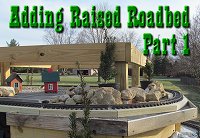 Return to "Adding Raised Roadbed to the NEW New Boston and Donnels Creek RR, Part 1" - Sorting out our priorities for the spring and summer of 2018. There a lot of little chores we really should get done before we start on the next big addition. Click to see our plans as of February 27, 2018. Return to "Adding Raised Roadbed to the NEW New Boston and Donnels Creek RR, Part 1" - Sorting out our priorities for the spring and summer of 2018. There a lot of little chores we really should get done before we start on the next big addition. Click to see our plans as of February 27, 2018.
Click on the photo to see our status as of February 20, 2018
 Return to "2018: Springing into Spring on the NEW New Boston & Donnels Creek RR." - Sorting out our priorities for the spring and summer of 2018. There a lot of little chores we really should get done before we start on the next big addition. Click to see our plans as of February 27, 2018. Return to "2018: Springing into Spring on the NEW New Boston & Donnels Creek RR." - Sorting out our priorities for the spring and summer of 2018. There a lot of little chores we really should get done before we start on the next big addition. Click to see our plans as of February 27, 2018.
Click on the photo to see our status as of February 20, 2018
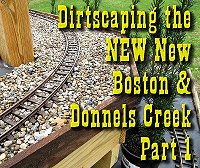 Return to "Dirtscaping the NEW New Boston and Donnels Creek RR, Part 1. - Putting edging around the existing "layers" of the new railroad, and beginning to add gravel and rocks. There were a few test runs, but we got stopped early by bad weather before we could dump the rest of the rocks, gravel, and dirt, much less plant the plants we hoped to get in before snowfall. Return to "Dirtscaping the NEW New Boston and Donnels Creek RR, Part 1. - Putting edging around the existing "layers" of the new railroad, and beginning to add gravel and rocks. There were a few test runs, but we got stopped early by bad weather before we could dump the rest of the rocks, gravel, and dirt, much less plant the plants we hoped to get in before snowfall.
Click on the photo to see our status as of November 21, 2017
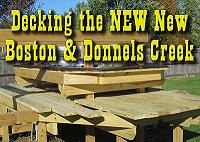 Return to "Decking the NEW New Boston and Donnels Creek RR - Decking the 'middle layer' of our proposed three-tier outdoor railroad. Prepping more track, laying out track and decking to make certain we have measurements correct, installing most of the remaining decking for this layer. Return to "Decking the NEW New Boston and Donnels Creek RR - Decking the 'middle layer' of our proposed three-tier outdoor railroad. Prepping more track, laying out track and decking to make certain we have measurements correct, installing most of the remaining decking for this layer.
Click on the photo to see our status as of October 25, 2017
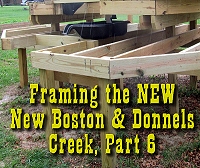 Return to "Framing the NEW New Boston and Donnels Creek RR, Part 6" - Modifying and finishing the framing on the second layer, cantilevering, using R3 track versus all other pre-curved track formats, finalizing the track plan, why painting the track makes old and new track blend better, and more. This will be the last bit of "framing" in 2017, and it worked out well, considering. Return to "Framing the NEW New Boston and Donnels Creek RR, Part 6" - Modifying and finishing the framing on the second layer, cantilevering, using R3 track versus all other pre-curved track formats, finalizing the track plan, why painting the track makes old and new track blend better, and more. This will be the last bit of "framing" in 2017, and it worked out well, considering.
Click on the photo to see our status as of October 15, 2017
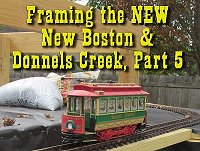 Return to "Framing the NEW New Boston and Donnels Creek RR, Part 5" - Spreading the billboard-sourced vinyl underlayment on the top layer. Prepping used Aristo track for (hopefully) many more years of service. Laying the first loop of track, attaching power wires with spade terminals, and testing conductivity with a Bachmann streetcar. Return to "Framing the NEW New Boston and Donnels Creek RR, Part 5" - Spreading the billboard-sourced vinyl underlayment on the top layer. Prepping used Aristo track for (hopefully) many more years of service. Laying the first loop of track, attaching power wires with spade terminals, and testing conductivity with a Bachmann streetcar.
Click on the photo to see our status as of October, 10, 2017
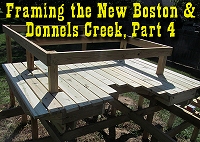 Return to "Framing the NEW New Boston and Donnels Creek RR, Part 4" - Planning and running the decking for the top layer, testing the track plan, checking clearances, prepping used track with new railjoiners, examining the vinyl I ordered to go over the decking, and more. Return to "Framing the NEW New Boston and Donnels Creek RR, Part 4" - Planning and running the decking for the top layer, testing the track plan, checking clearances, prepping used track with new railjoiners, examining the vinyl I ordered to go over the decking, and more.
Click on the photo to see our status as of September 26, 2017
 Return to "Framing the NEW New Boston and Donnels Creek RR, Part 3" -
Getting the frame finished on the top layer, ordering other things I'd need eventually, deciding on materials for the decking on the top layer (at least). Return to "Framing the NEW New Boston and Donnels Creek RR, Part 3" -
Getting the frame finished on the top layer, ordering other things I'd need eventually, deciding on materials for the decking on the top layer (at least).
Click on the photo to see our status as of September 17, 2017
 Return to "Framing the NEW New Boston and Donnels Creek RR, Part 2" -
Once I had the overall frame relatively solid, I hooked up the underground power lines to two GFI plugs that should be in easy reach once everything is finished. I also decided to frame out the top railroad layer while I could still access the center of the railroad easily. Because I was running out of vertical space, I reconfigured that layer. Then after I got the "core" pieces on, I changed my plan again. But the whole thing is getting easier and easier to visualize, and is getting closer to complete with every board I cut and fasten on. Return to "Framing the NEW New Boston and Donnels Creek RR, Part 2" -
Once I had the overall frame relatively solid, I hooked up the underground power lines to two GFI plugs that should be in easy reach once everything is finished. I also decided to frame out the top railroad layer while I could still access the center of the railroad easily. Because I was running out of vertical space, I reconfigured that layer. Then after I got the "core" pieces on, I changed my plan again. But the whole thing is getting easier and easier to visualize, and is getting closer to complete with every board I cut and fasten on.
Click on the photo to see our status as of September 7, 2017
 Return to "Framing the NEW New Boston and Donnels Creek RR, Part 1" -
Once I started dropping posts in the holes and screwing things together, I didn't want to stop before I had the basic frame built (for one thing, the wood warps less once it's fastened in place). Now the folks driving down the street past our house (we're on a corner lot) probably wonder if I'm building an elaborate chicken coop, but that's fine with me. I still need to make a few more lumber runs and do a lot more cutting and sawing, but having the basic frame in place should make the next bits a lot easier. Return to "Framing the NEW New Boston and Donnels Creek RR, Part 1" -
Once I started dropping posts in the holes and screwing things together, I didn't want to stop before I had the basic frame built (for one thing, the wood warps less once it's fastened in place). Now the folks driving down the street past our house (we're on a corner lot) probably wonder if I'm building an elaborate chicken coop, but that's fine with me. I still need to make a few more lumber runs and do a lot more cutting and sawing, but having the basic frame in place should make the next bits a lot easier.
Click on the photo to see our status as of August 10, 2017
 Return to "Breaking Ground on the NEW New Boston and Donnels Creek" -
Okay, in case you wondered if we'd ever get started on the thing, we broke ground in July, using a manual post-hole digger. Well two manual post-hole diggers. But by the end of this article, we're ready for the posts to start going in. Return to "Breaking Ground on the NEW New Boston and Donnels Creek" -
Okay, in case you wondered if we'd ever get started on the thing, we broke ground in July, using a manual post-hole digger. Well two manual post-hole diggers. But by the end of this article, we're ready for the posts to start going in.
Click on the photo to see our status as of the end of July, 2017
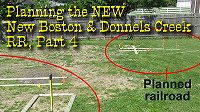 Return to "Planning the NEW New Boston and Donnels Creek, Part 4" -
Well, the rented post-hole digger fell through, so we dug our vegetable garden with a manual post-hole digger (the scissors kind). In addition, I stake out where the railroad was going to be. Twice. And tweaked the plans again. Sorry about the redo's, but sometimes just walking around the yard trying to visualize things makes me reconsider something that seemed "settled" only a few days before. Return to "Planning the NEW New Boston and Donnels Creek, Part 4" -
Well, the rented post-hole digger fell through, so we dug our vegetable garden with a manual post-hole digger (the scissors kind). In addition, I stake out where the railroad was going to be. Twice. And tweaked the plans again. Sorry about the redo's, but sometimes just walking around the yard trying to visualize things makes me reconsider something that seemed "settled" only a few days before.
Click on the photo to see what we were considering as of late May, 2017
 Return to "Planning the NEW New Boston and Donnels Creek, Part 3" -
We have still not broken ground. In part because we plan to rent a post-hole digger and dig the post holes for our raised vegetable garden and the first phase of the garden railroad at the same time, and we don't have enough lumber on hand yet. (If we didn't break it down into multiple trips, we'd be blowing out the shocks on our minivan.) In the meantime, we used a line level to see if the slope of the back yard was as bad as we thought it was (it's worse), and we did other site preparation, including planting a whole bunch of spruce tree seedlings to eventually give us some privacy in our side and back yard. Plus, I'm still wavering a little on the "where-to-start-first" issue. Return to "Planning the NEW New Boston and Donnels Creek, Part 3" -
We have still not broken ground. In part because we plan to rent a post-hole digger and dig the post holes for our raised vegetable garden and the first phase of the garden railroad at the same time, and we don't have enough lumber on hand yet. (If we didn't break it down into multiple trips, we'd be blowing out the shocks on our minivan.) In the meantime, we used a line level to see if the slope of the back yard was as bad as we thought it was (it's worse), and we did other site preparation, including planting a whole bunch of spruce tree seedlings to eventually give us some privacy in our side and back yard. Plus, I'm still wavering a little on the "where-to-start-first" issue.
Click on the photo to see what we were considering as of late April, 2017
 Return to "Planning the NEW New Boston and Donnels Creek, Part 2" -
More plans. We've moved on from the 2"x6" roadbed-on-posts to a sort of "train-table-outside" plan. Our goals include low-maintenance, high interest, and high reliability. We're also trying to get around having a thousand dollars' worth of dirt hauled into the back yard. If you want to get some idea of what our planning process looks like, reading these through in sequence may help. Or it may drive you crazy. Return to "Planning the NEW New Boston and Donnels Creek, Part 2" -
More plans. We've moved on from the 2"x6" roadbed-on-posts to a sort of "train-table-outside" plan. Our goals include low-maintenance, high interest, and high reliability. We're also trying to get around having a thousand dollars' worth of dirt hauled into the back yard. If you want to get some idea of what our planning process looks like, reading these through in sequence may help. Or it may drive you crazy.
Click on the photo to see what we were considering in early April, 2017
 Return to "Planning the NEW New Boston and Donnels Creek, Part 1" -
If you're subscribed to our newsletter, you know that we moved just after Thanksgiving in 2016, leaving behind most of the track, a few of the bird feeders, and one Bachmann train set for the new owners. We also left behind a high-maintenance garden that we do not intend to replicate at the new place. This is the first chapter of a new chapter in our lives, which we hope will include a lot of "lessons learned." But first, some serious landscaping had to take place. Return to "Planning the NEW New Boston and Donnels Creek, Part 1" -
If you're subscribed to our newsletter, you know that we moved just after Thanksgiving in 2016, leaving behind most of the track, a few of the bird feeders, and one Bachmann train set for the new owners. We also left behind a high-maintenance garden that we do not intend to replicate at the new place. This is the first chapter of a new chapter in our lives, which we hope will include a lot of "lessons learned." But first, some serious landscaping had to take place.
Click on the photo to see what we were considering in March, 2017
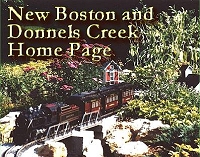 Return to the New Boston and Donnels Creek RR Page - This is the page describing Paul Race's progress and frequent rework on his own garden railroad, started on a shoe-string budget in 1998, later expanded, and later refurbished several times as issues arose. Issues that Paul hopes to avoid by building the next iteration above ground. Return to the New Boston and Donnels Creek RR Page - This is the page describing Paul Race's progress and frequent rework on his own garden railroad, started on a shoe-string budget in 1998, later expanded, and later refurbished several times as issues arose. Issues that Paul hopes to avoid by building the next iteration above ground.
Click on the photo to see the home page of Paul's railroad.
 Return to Family Garden Trains' Home Page - The home page with links to all the other stuff, including design guidelines, construction techniques, structure tips, free graphics, and more. Return to Family Garden Trains' Home Page - The home page with links to all the other stuff, including design guidelines, construction techniques, structure tips, free graphics, and more.
To read more, or to look at recommended Garden Railroading and Big Indoor Train products, please click on the index pages below.
| 














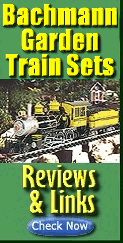




















































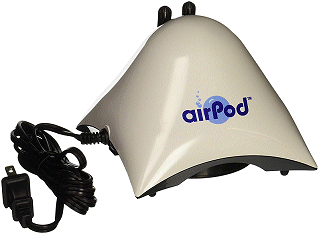
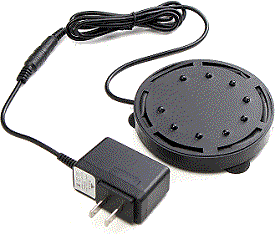


 Proceed to Expansion Planning, 2020"
Proceed to Expansion Planning, 2020" Return to "Preparing for Christmas Train Day 2019"
Return to "Preparing for Christmas Train Day 2019" Return to Decking the NEW New Boston and Donnels Creek Part 2
Return to Decking the NEW New Boston and Donnels Creek Part 2 Return to "Framing the NEW New Boston and Donnels Creek RR - Part 7"
Return to "Framing the NEW New Boston and Donnels Creek RR - Part 7" Return to "Planning the NEW New Boston and Donnels Creek RR - Part 5"
Return to "Planning the NEW New Boston and Donnels Creek RR - Part 5" Return to Waterscaping Part 4.
Return to Waterscaping Part 4. Return to "Waterscaping, Part 3"
Return to "Waterscaping, Part 3" Return to Christmas Train Day, 2018
Return to Christmas Train Day, 2018 Return to "Adding a Train Shed Part 6"
Return to "Adding a Train Shed Part 6" Return to "Adding a Train Shed Part 5"
Return to "Adding a Train Shed Part 5" Return to "Adding a Train Shed Part 4"
Return to "Adding a Train Shed Part 4" Return to "Adding a Train Shed Part 3"
Return to "Adding a Train Shed Part 3" Return to "Waterscaping Part 2"
Return to "Waterscaping Part 2" Return to "Adding a Train Shed Part 2"
Return to "Adding a Train Shed Part 2" Return to "Adding a Train Shed Part 1"
Return to "Adding a Train Shed Part 1" Return to "Waterscaping the NEW New Boston and Donnels Creek Part 1,"
Return to "Waterscaping the NEW New Boston and Donnels Creek Part 1,"  Return to "Dirtscaping the NEW New Boston and Donnels Creek RR, Part 2.
Return to "Dirtscaping the NEW New Boston and Donnels Creek RR, Part 2. Return to "Adding Raised Roadbed to the NEW New Boston and Donnels Creek, Part 2"
Return to "Adding Raised Roadbed to the NEW New Boston and Donnels Creek, Part 2" Return to "Adding Raised Roadbed to the NEW New Boston and Donnels Creek RR, Part 1"
Return to "Adding Raised Roadbed to the NEW New Boston and Donnels Creek RR, Part 1" Return to "2018: Springing into Spring on the NEW New Boston & Donnels Creek RR."
Return to "2018: Springing into Spring on the NEW New Boston & Donnels Creek RR." Return to "Dirtscaping the NEW New Boston and Donnels Creek RR, Part 1.
Return to "Dirtscaping the NEW New Boston and Donnels Creek RR, Part 1. Return to "Decking the NEW New Boston and Donnels Creek RR
Return to "Decking the NEW New Boston and Donnels Creek RR Return to "Framing the NEW New Boston and Donnels Creek RR, Part 6"
Return to "Framing the NEW New Boston and Donnels Creek RR, Part 6" Return to "Framing the NEW New Boston and Donnels Creek RR, Part 5"
Return to "Framing the NEW New Boston and Donnels Creek RR, Part 5" Return to "Framing the NEW New Boston and Donnels Creek RR, Part 4"
Return to "Framing the NEW New Boston and Donnels Creek RR, Part 4" Return to "Framing the NEW New Boston and Donnels Creek RR, Part 3"
Return to "Framing the NEW New Boston and Donnels Creek RR, Part 3" Return to "Framing the NEW New Boston and Donnels Creek RR, Part 2"
Return to "Framing the NEW New Boston and Donnels Creek RR, Part 2" Return to "Framing the NEW New Boston and Donnels Creek RR, Part 1"
Return to "Framing the NEW New Boston and Donnels Creek RR, Part 1" Return to "Breaking Ground on the NEW New Boston and Donnels Creek"
Return to "Breaking Ground on the NEW New Boston and Donnels Creek" Return to "Planning the NEW New Boston and Donnels Creek, Part 4"
Return to "Planning the NEW New Boston and Donnels Creek, Part 4" Return to "Planning the NEW New Boston and Donnels Creek, Part 3"
Return to "Planning the NEW New Boston and Donnels Creek, Part 3" Return to "Planning the NEW New Boston and Donnels Creek, Part 2"
Return to "Planning the NEW New Boston and Donnels Creek, Part 2" Return to "Planning the NEW New Boston and Donnels Creek, Part 1"
Return to "Planning the NEW New Boston and Donnels Creek, Part 1" Return to the New Boston and Donnels Creek RR Page
Return to the New Boston and Donnels Creek RR Page Return to Family Garden Trains' Home Page
Return to Family Garden Trains' Home Page